Health Economics Assignment: Demand, Supply, and Externalities
VerifiedAdded on 2023/01/19
|10
|2023
|59
Homework Assignment
AI Summary
This health economics assignment delves into various crucial concepts within the field. It begins by analyzing the impact of price elasticity on GP services and emergency department services, exploring how changes in co-payments affect utilization. The assignment then examines externalities, particularly focusing on the negative impacts of tobacco smoking on both active and passive smokers, illustrating the resulting deadweight loss and market inefficiencies. Furthermore, the assignment explores production costs, constructing a table to calculate average and marginal costs, and determining the profit-maximizing level of production for a firm under given market conditions. The analysis continues by examining the equilibrium in the physiotherapy services market, including the effects of government-imposed price floors. Finally, the assignment discusses supplier-induced demand, explaining how information asymmetry in the doctor-patient relationship can lead to inefficient resource allocation and overconsumption of healthcare services, highlighting the economic concerns associated with this phenomenon.
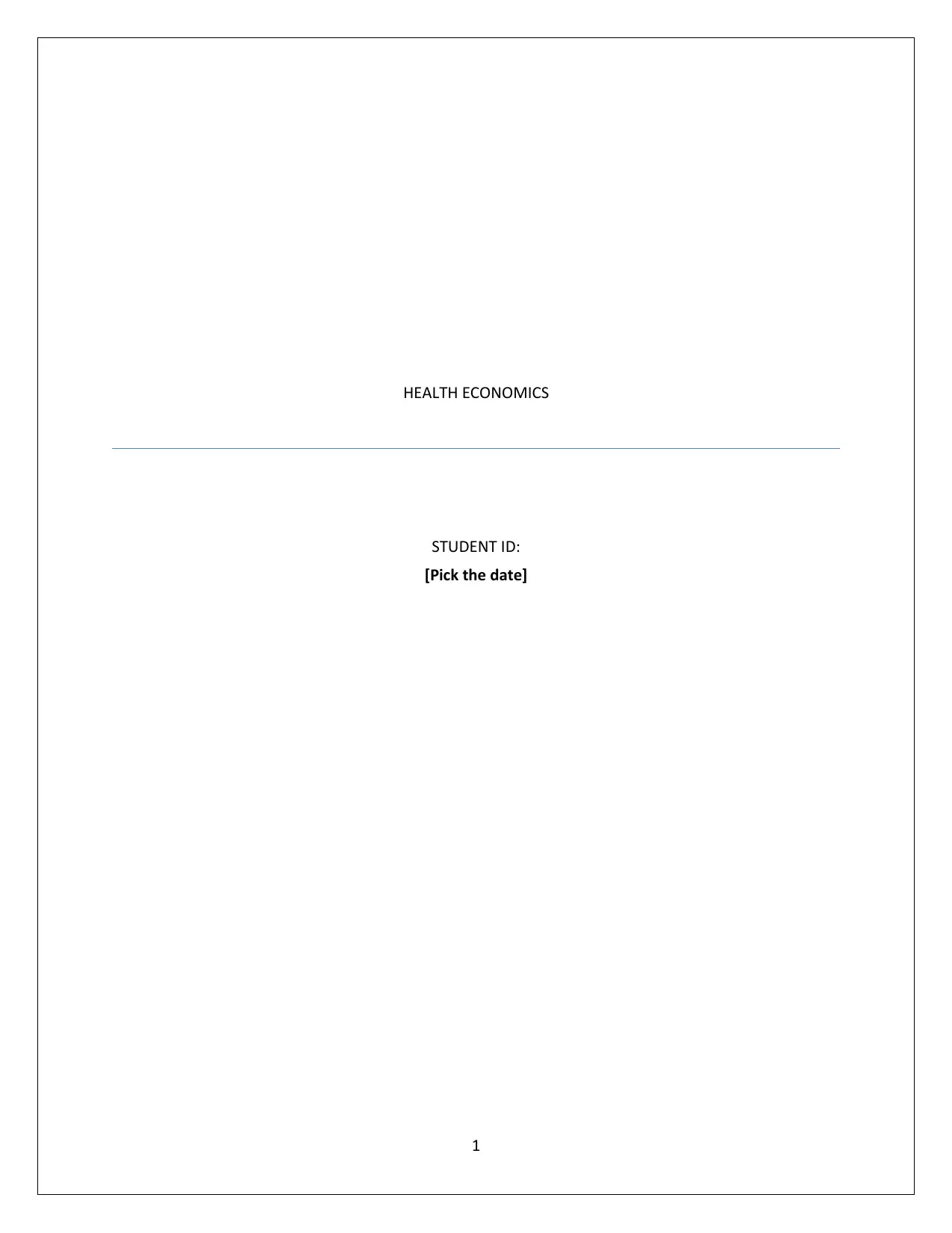
HEALTH ECONOMICS
STUDENT ID:
[Pick the date]
1
STUDENT ID:
[Pick the date]
1
Paraphrase This Document
Need a fresh take? Get an instant paraphrase of this document with our AI Paraphraser
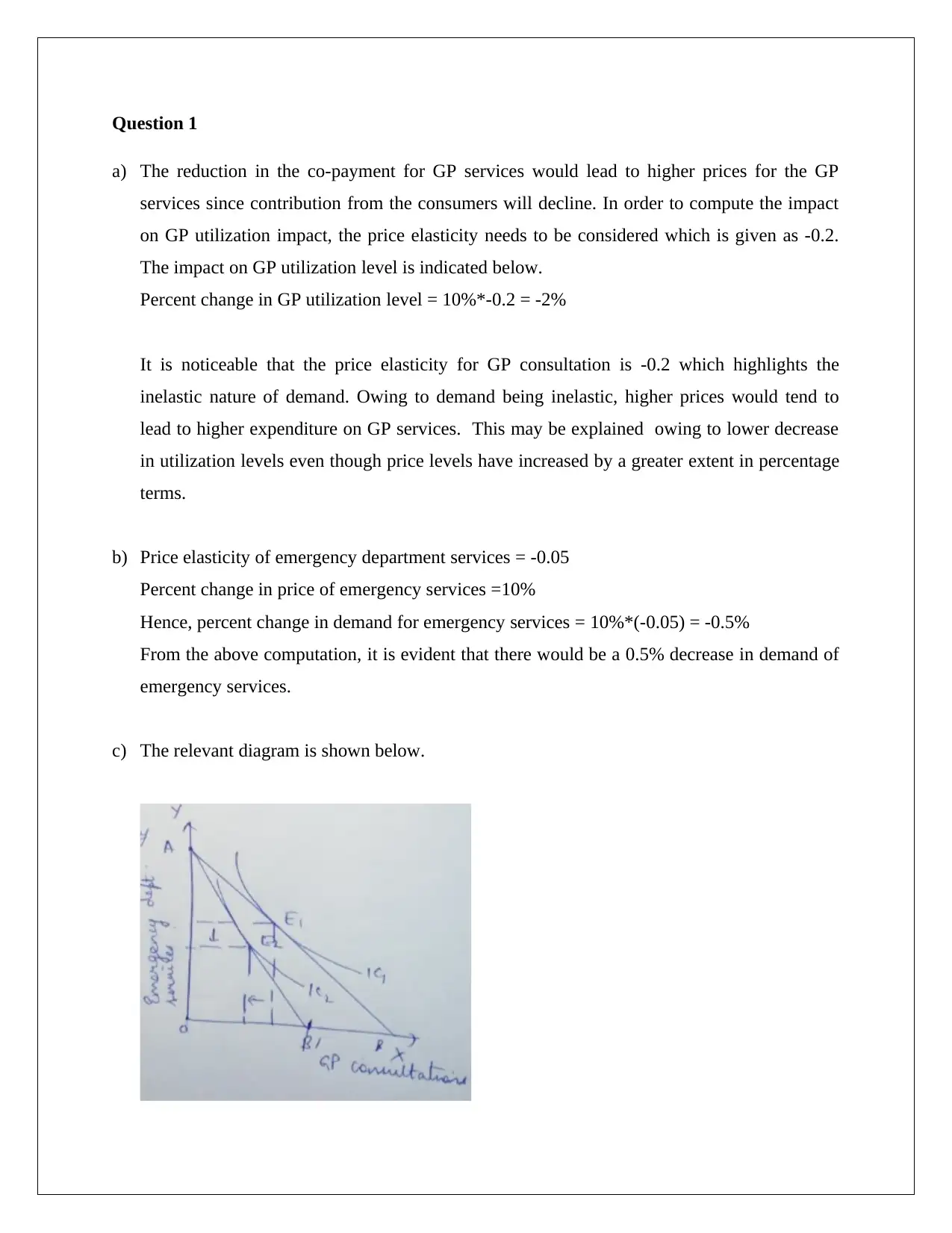
Question 1
a) The reduction in the co-payment for GP services would lead to higher prices for the GP
services since contribution from the consumers will decline. In order to compute the impact
on GP utilization impact, the price elasticity needs to be considered which is given as -0.2.
The impact on GP utilization level is indicated below.
Percent change in GP utilization level = 10%*-0.2 = -2%
It is noticeable that the price elasticity for GP consultation is -0.2 which highlights the
inelastic nature of demand. Owing to demand being inelastic, higher prices would tend to
lead to higher expenditure on GP services. This may be explained owing to lower decrease
in utilization levels even though price levels have increased by a greater extent in percentage
terms.
b) Price elasticity of emergency department services = -0.05
Percent change in price of emergency services =10%
Hence, percent change in demand for emergency services = 10%*(-0.05) = -0.5%
From the above computation, it is evident that there would be a 0.5% decrease in demand of
emergency services.
c) The relevant diagram is shown below.
a) The reduction in the co-payment for GP services would lead to higher prices for the GP
services since contribution from the consumers will decline. In order to compute the impact
on GP utilization impact, the price elasticity needs to be considered which is given as -0.2.
The impact on GP utilization level is indicated below.
Percent change in GP utilization level = 10%*-0.2 = -2%
It is noticeable that the price elasticity for GP consultation is -0.2 which highlights the
inelastic nature of demand. Owing to demand being inelastic, higher prices would tend to
lead to higher expenditure on GP services. This may be explained owing to lower decrease
in utilization levels even though price levels have increased by a greater extent in percentage
terms.
b) Price elasticity of emergency department services = -0.05
Percent change in price of emergency services =10%
Hence, percent change in demand for emergency services = 10%*(-0.05) = -0.5%
From the above computation, it is evident that there would be a 0.5% decrease in demand of
emergency services.
c) The relevant diagram is shown below.
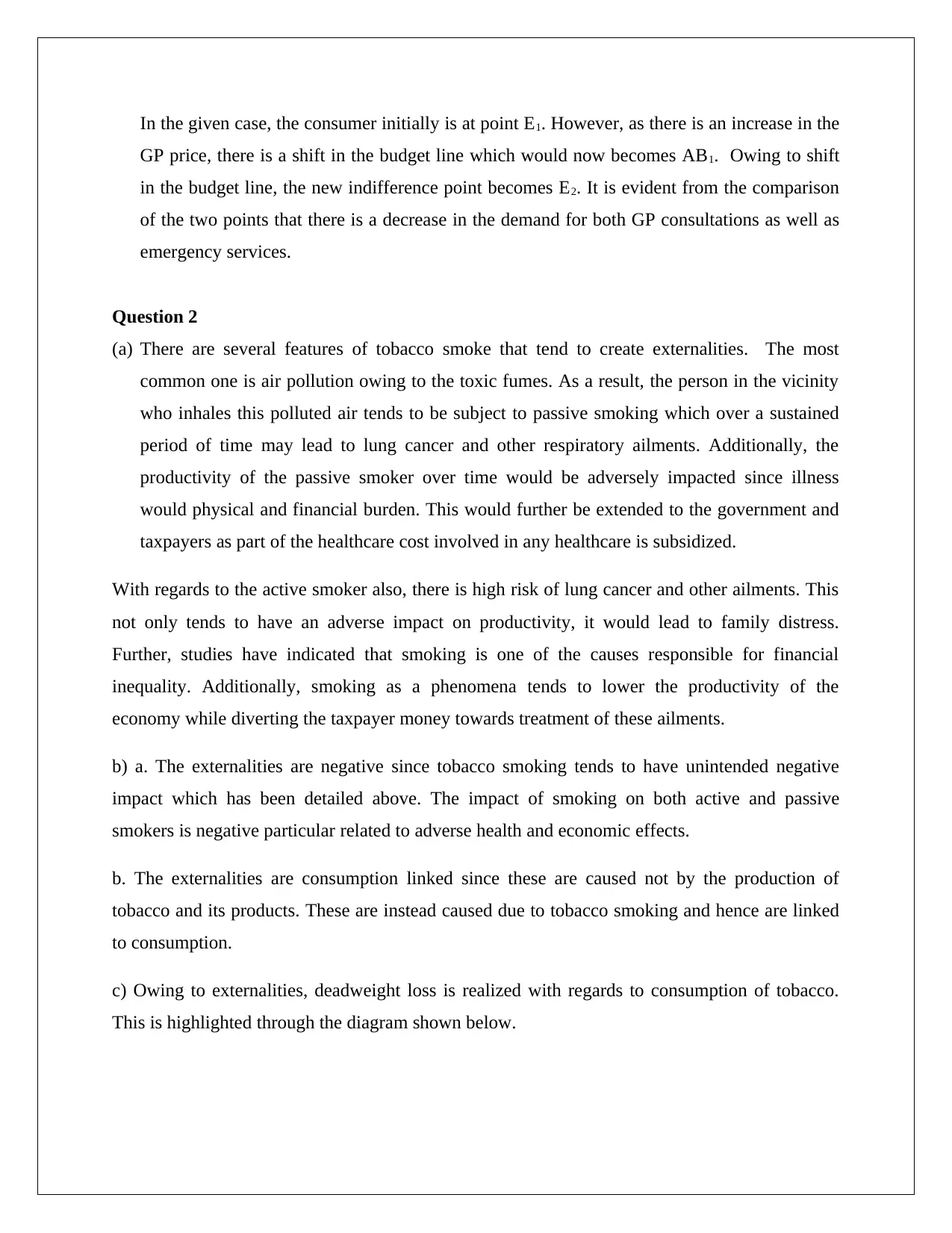
In the given case, the consumer initially is at point E1. However, as there is an increase in the
GP price, there is a shift in the budget line which would now becomes AB1. Owing to shift
in the budget line, the new indifference point becomes E2. It is evident from the comparison
of the two points that there is a decrease in the demand for both GP consultations as well as
emergency services.
Question 2
(a) There are several features of tobacco smoke that tend to create externalities. The most
common one is air pollution owing to the toxic fumes. As a result, the person in the vicinity
who inhales this polluted air tends to be subject to passive smoking which over a sustained
period of time may lead to lung cancer and other respiratory ailments. Additionally, the
productivity of the passive smoker over time would be adversely impacted since illness
would physical and financial burden. This would further be extended to the government and
taxpayers as part of the healthcare cost involved in any healthcare is subsidized.
With regards to the active smoker also, there is high risk of lung cancer and other ailments. This
not only tends to have an adverse impact on productivity, it would lead to family distress.
Further, studies have indicated that smoking is one of the causes responsible for financial
inequality. Additionally, smoking as a phenomena tends to lower the productivity of the
economy while diverting the taxpayer money towards treatment of these ailments.
b) a. The externalities are negative since tobacco smoking tends to have unintended negative
impact which has been detailed above. The impact of smoking on both active and passive
smokers is negative particular related to adverse health and economic effects.
b. The externalities are consumption linked since these are caused not by the production of
tobacco and its products. These are instead caused due to tobacco smoking and hence are linked
to consumption.
c) Owing to externalities, deadweight loss is realized with regards to consumption of tobacco.
This is highlighted through the diagram shown below.
GP price, there is a shift in the budget line which would now becomes AB1. Owing to shift
in the budget line, the new indifference point becomes E2. It is evident from the comparison
of the two points that there is a decrease in the demand for both GP consultations as well as
emergency services.
Question 2
(a) There are several features of tobacco smoke that tend to create externalities. The most
common one is air pollution owing to the toxic fumes. As a result, the person in the vicinity
who inhales this polluted air tends to be subject to passive smoking which over a sustained
period of time may lead to lung cancer and other respiratory ailments. Additionally, the
productivity of the passive smoker over time would be adversely impacted since illness
would physical and financial burden. This would further be extended to the government and
taxpayers as part of the healthcare cost involved in any healthcare is subsidized.
With regards to the active smoker also, there is high risk of lung cancer and other ailments. This
not only tends to have an adverse impact on productivity, it would lead to family distress.
Further, studies have indicated that smoking is one of the causes responsible for financial
inequality. Additionally, smoking as a phenomena tends to lower the productivity of the
economy while diverting the taxpayer money towards treatment of these ailments.
b) a. The externalities are negative since tobacco smoking tends to have unintended negative
impact which has been detailed above. The impact of smoking on both active and passive
smokers is negative particular related to adverse health and economic effects.
b. The externalities are consumption linked since these are caused not by the production of
tobacco and its products. These are instead caused due to tobacco smoking and hence are linked
to consumption.
c) Owing to externalities, deadweight loss is realized with regards to consumption of tobacco.
This is highlighted through the diagram shown below.
⊘ This is a preview!⊘
Do you want full access?
Subscribe today to unlock all pages.

Trusted by 1+ million students worldwide
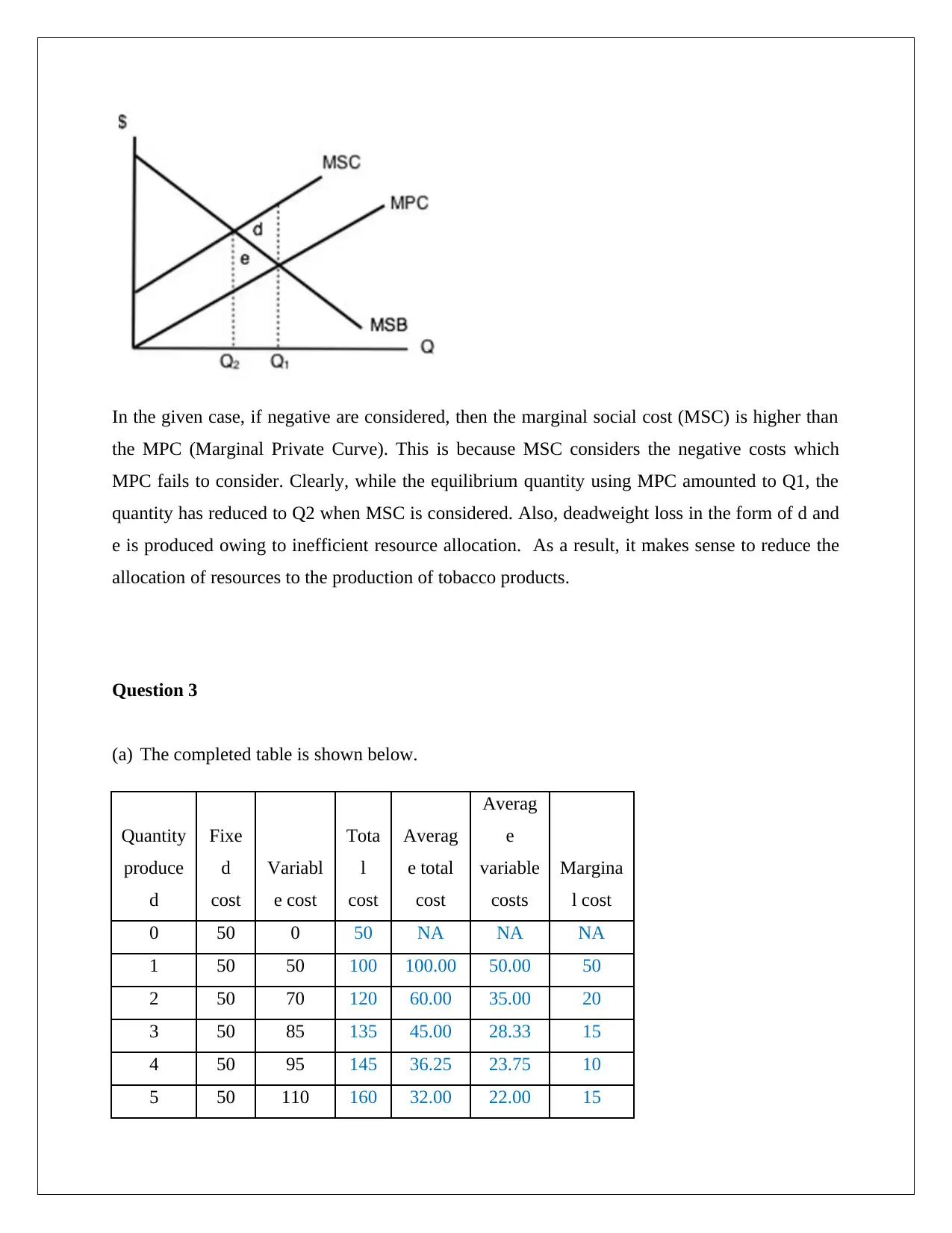
In the given case, if negative are considered, then the marginal social cost (MSC) is higher than
the MPC (Marginal Private Curve). This is because MSC considers the negative costs which
MPC fails to consider. Clearly, while the equilibrium quantity using MPC amounted to Q1, the
quantity has reduced to Q2 when MSC is considered. Also, deadweight loss in the form of d and
e is produced owing to inefficient resource allocation. As a result, it makes sense to reduce the
allocation of resources to the production of tobacco products.
Question 3
(a) The completed table is shown below.
Quantity
produce
d
Fixe
d
cost
Variabl
e cost
Tota
l
cost
Averag
e total
cost
Averag
e
variable
costs
Margina
l cost
0 50 0 50 NA NA NA
1 50 50 100 100.00 50.00 50
2 50 70 120 60.00 35.00 20
3 50 85 135 45.00 28.33 15
4 50 95 145 36.25 23.75 10
5 50 110 160 32.00 22.00 15
the MPC (Marginal Private Curve). This is because MSC considers the negative costs which
MPC fails to consider. Clearly, while the equilibrium quantity using MPC amounted to Q1, the
quantity has reduced to Q2 when MSC is considered. Also, deadweight loss in the form of d and
e is produced owing to inefficient resource allocation. As a result, it makes sense to reduce the
allocation of resources to the production of tobacco products.
Question 3
(a) The completed table is shown below.
Quantity
produce
d
Fixe
d
cost
Variabl
e cost
Tota
l
cost
Averag
e total
cost
Averag
e
variable
costs
Margina
l cost
0 50 0 50 NA NA NA
1 50 50 100 100.00 50.00 50
2 50 70 120 60.00 35.00 20
3 50 85 135 45.00 28.33 15
4 50 95 145 36.25 23.75 10
5 50 110 160 32.00 22.00 15
Paraphrase This Document
Need a fresh take? Get an instant paraphrase of this document with our AI Paraphraser
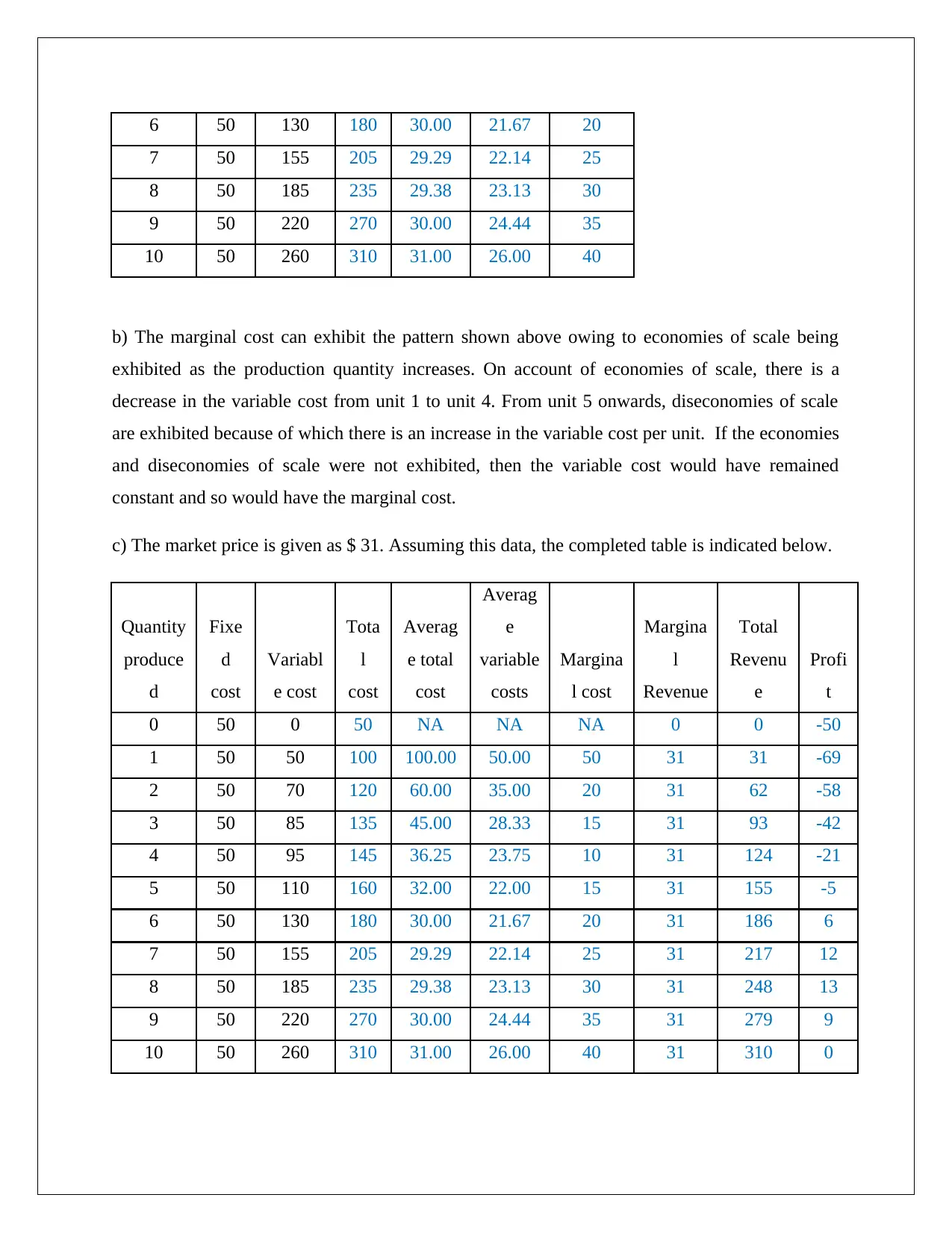
6 50 130 180 30.00 21.67 20
7 50 155 205 29.29 22.14 25
8 50 185 235 29.38 23.13 30
9 50 220 270 30.00 24.44 35
10 50 260 310 31.00 26.00 40
b) The marginal cost can exhibit the pattern shown above owing to economies of scale being
exhibited as the production quantity increases. On account of economies of scale, there is a
decrease in the variable cost from unit 1 to unit 4. From unit 5 onwards, diseconomies of scale
are exhibited because of which there is an increase in the variable cost per unit. If the economies
and diseconomies of scale were not exhibited, then the variable cost would have remained
constant and so would have the marginal cost.
c) The market price is given as $ 31. Assuming this data, the completed table is indicated below.
Quantity
produce
d
Fixe
d
cost
Variabl
e cost
Tota
l
cost
Averag
e total
cost
Averag
e
variable
costs
Margina
l cost
Margina
l
Revenue
Total
Revenu
e
Profi
t
0 50 0 50 NA NA NA 0 0 -50
1 50 50 100 100.00 50.00 50 31 31 -69
2 50 70 120 60.00 35.00 20 31 62 -58
3 50 85 135 45.00 28.33 15 31 93 -42
4 50 95 145 36.25 23.75 10 31 124 -21
5 50 110 160 32.00 22.00 15 31 155 -5
6 50 130 180 30.00 21.67 20 31 186 6
7 50 155 205 29.29 22.14 25 31 217 12
8 50 185 235 29.38 23.13 30 31 248 13
9 50 220 270 30.00 24.44 35 31 279 9
10 50 260 310 31.00 26.00 40 31 310 0
7 50 155 205 29.29 22.14 25
8 50 185 235 29.38 23.13 30
9 50 220 270 30.00 24.44 35
10 50 260 310 31.00 26.00 40
b) The marginal cost can exhibit the pattern shown above owing to economies of scale being
exhibited as the production quantity increases. On account of economies of scale, there is a
decrease in the variable cost from unit 1 to unit 4. From unit 5 onwards, diseconomies of scale
are exhibited because of which there is an increase in the variable cost per unit. If the economies
and diseconomies of scale were not exhibited, then the variable cost would have remained
constant and so would have the marginal cost.
c) The market price is given as $ 31. Assuming this data, the completed table is indicated below.
Quantity
produce
d
Fixe
d
cost
Variabl
e cost
Tota
l
cost
Averag
e total
cost
Averag
e
variable
costs
Margina
l cost
Margina
l
Revenue
Total
Revenu
e
Profi
t
0 50 0 50 NA NA NA 0 0 -50
1 50 50 100 100.00 50.00 50 31 31 -69
2 50 70 120 60.00 35.00 20 31 62 -58
3 50 85 135 45.00 28.33 15 31 93 -42
4 50 95 145 36.25 23.75 10 31 124 -21
5 50 110 160 32.00 22.00 15 31 155 -5
6 50 130 180 30.00 21.67 20 31 186 6
7 50 155 205 29.29 22.14 25 31 217 12
8 50 185 235 29.38 23.13 30 31 248 13
9 50 220 270 30.00 24.44 35 31 279 9
10 50 260 310 31.00 26.00 40 31 310 0
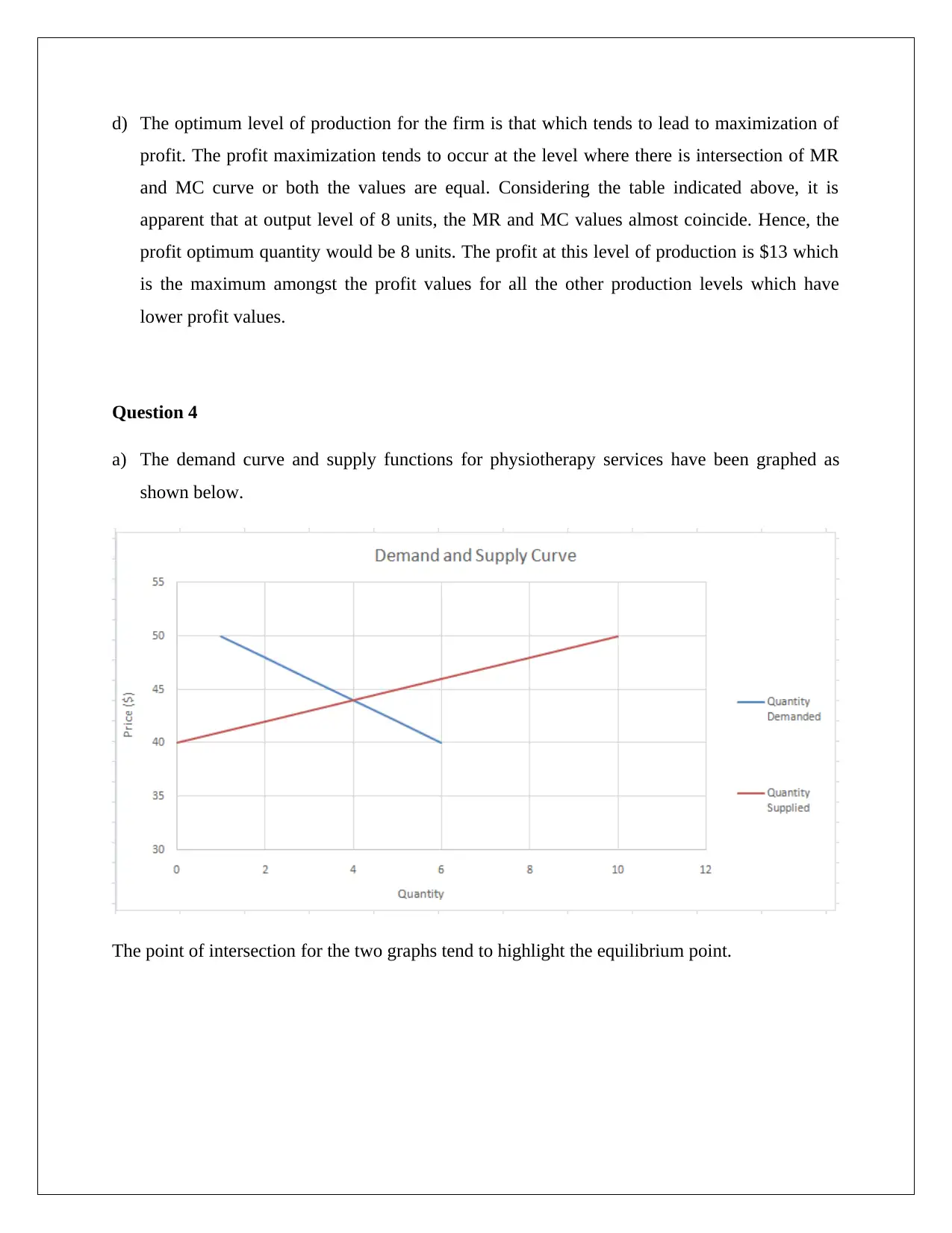
d) The optimum level of production for the firm is that which tends to lead to maximization of
profit. The profit maximization tends to occur at the level where there is intersection of MR
and MC curve or both the values are equal. Considering the table indicated above, it is
apparent that at output level of 8 units, the MR and MC values almost coincide. Hence, the
profit optimum quantity would be 8 units. The profit at this level of production is $13 which
is the maximum amongst the profit values for all the other production levels which have
lower profit values.
Question 4
a) The demand curve and supply functions for physiotherapy services have been graphed as
shown below.
The point of intersection for the two graphs tend to highlight the equilibrium point.
profit. The profit maximization tends to occur at the level where there is intersection of MR
and MC curve or both the values are equal. Considering the table indicated above, it is
apparent that at output level of 8 units, the MR and MC values almost coincide. Hence, the
profit optimum quantity would be 8 units. The profit at this level of production is $13 which
is the maximum amongst the profit values for all the other production levels which have
lower profit values.
Question 4
a) The demand curve and supply functions for physiotherapy services have been graphed as
shown below.
The point of intersection for the two graphs tend to highlight the equilibrium point.
⊘ This is a preview!⊘
Do you want full access?
Subscribe today to unlock all pages.

Trusted by 1+ million students worldwide
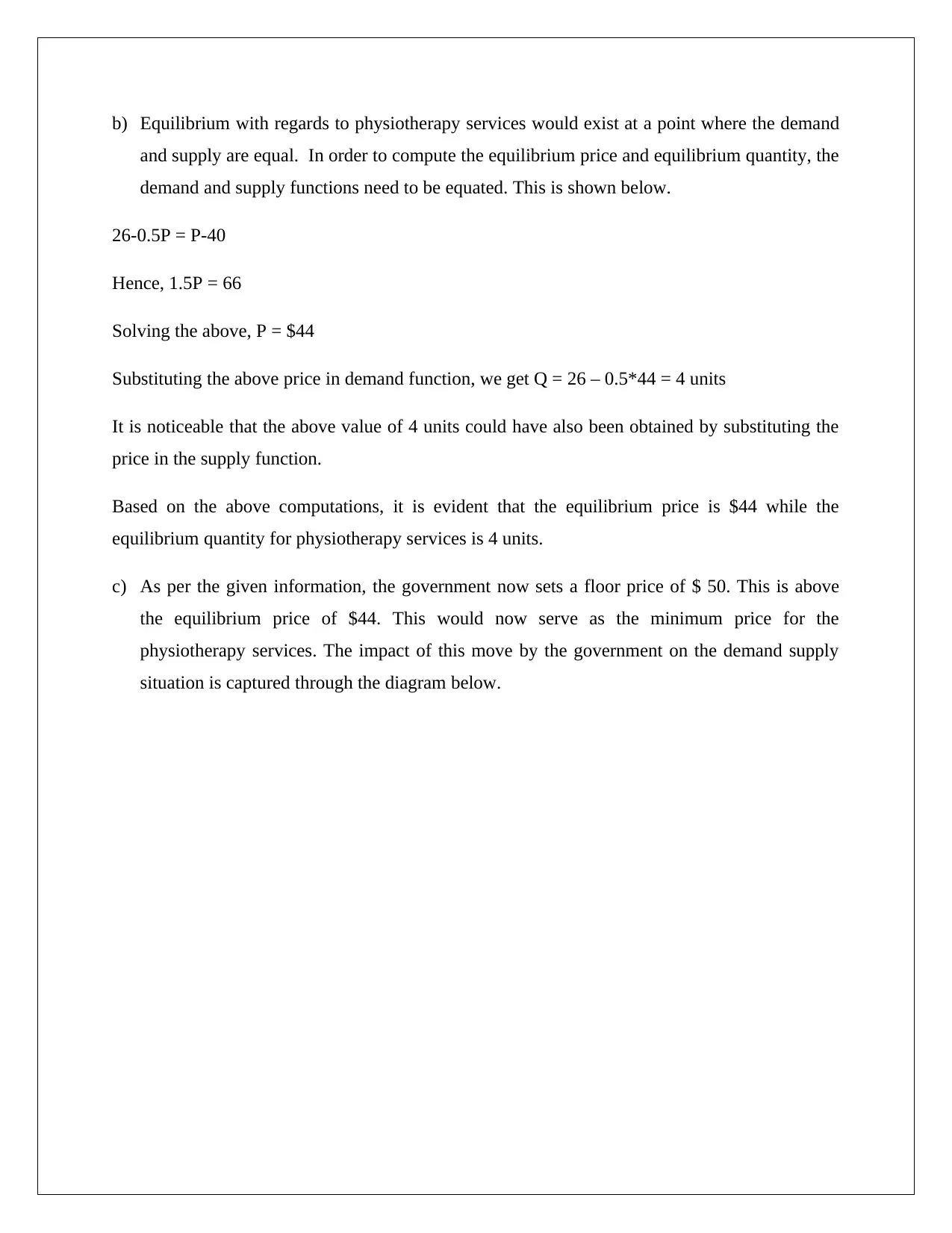
b) Equilibrium with regards to physiotherapy services would exist at a point where the demand
and supply are equal. In order to compute the equilibrium price and equilibrium quantity, the
demand and supply functions need to be equated. This is shown below.
26-0.5P = P-40
Hence, 1.5P = 66
Solving the above, P = $44
Substituting the above price in demand function, we get Q = 26 – 0.5*44 = 4 units
It is noticeable that the above value of 4 units could have also been obtained by substituting the
price in the supply function.
Based on the above computations, it is evident that the equilibrium price is $44 while the
equilibrium quantity for physiotherapy services is 4 units.
c) As per the given information, the government now sets a floor price of $ 50. This is above
the equilibrium price of $44. This would now serve as the minimum price for the
physiotherapy services. The impact of this move by the government on the demand supply
situation is captured through the diagram below.
and supply are equal. In order to compute the equilibrium price and equilibrium quantity, the
demand and supply functions need to be equated. This is shown below.
26-0.5P = P-40
Hence, 1.5P = 66
Solving the above, P = $44
Substituting the above price in demand function, we get Q = 26 – 0.5*44 = 4 units
It is noticeable that the above value of 4 units could have also been obtained by substituting the
price in the supply function.
Based on the above computations, it is evident that the equilibrium price is $44 while the
equilibrium quantity for physiotherapy services is 4 units.
c) As per the given information, the government now sets a floor price of $ 50. This is above
the equilibrium price of $44. This would now serve as the minimum price for the
physiotherapy services. The impact of this move by the government on the demand supply
situation is captured through the diagram below.
Paraphrase This Document
Need a fresh take? Get an instant paraphrase of this document with our AI Paraphraser
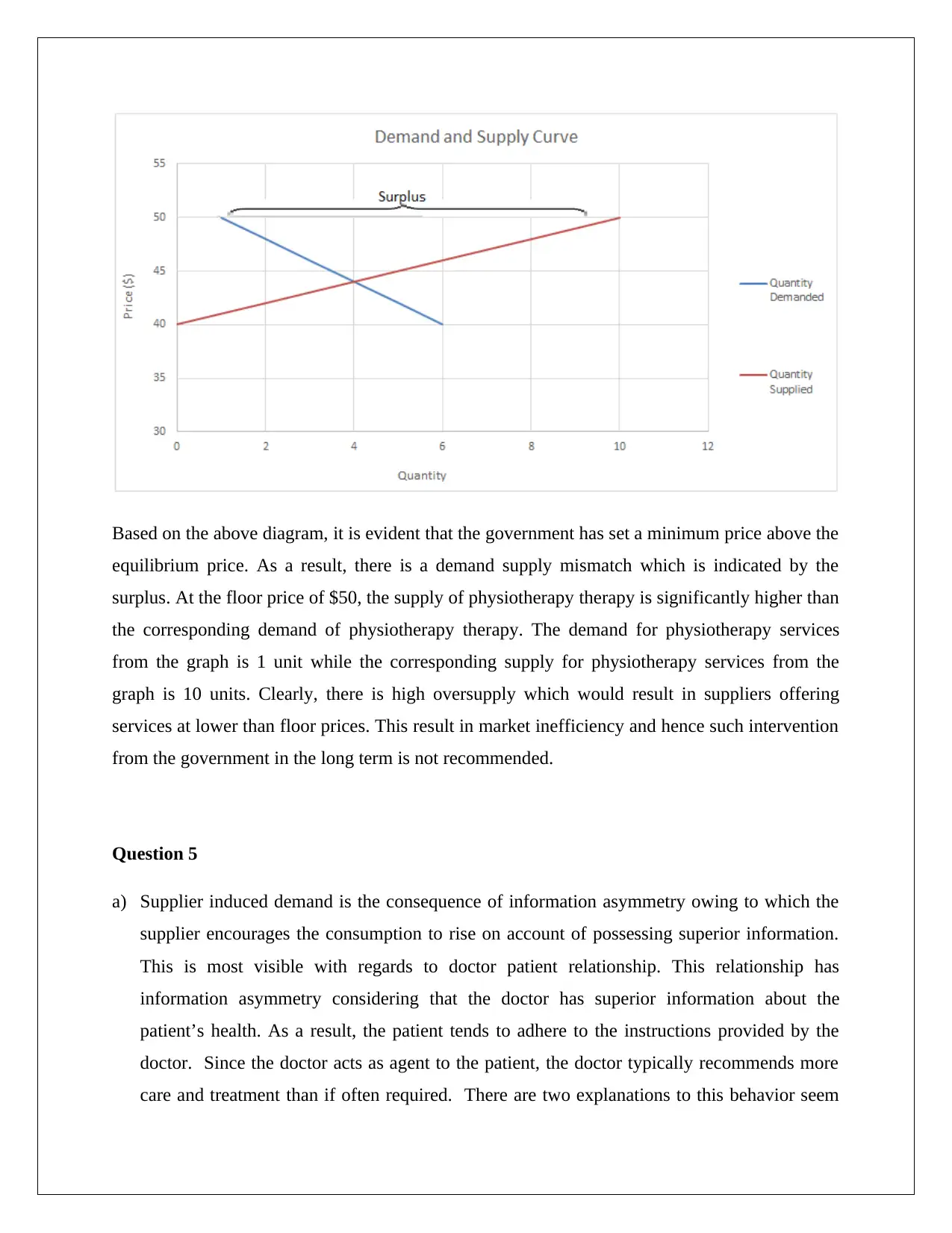
Based on the above diagram, it is evident that the government has set a minimum price above the
equilibrium price. As a result, there is a demand supply mismatch which is indicated by the
surplus. At the floor price of $50, the supply of physiotherapy therapy is significantly higher than
the corresponding demand of physiotherapy therapy. The demand for physiotherapy services
from the graph is 1 unit while the corresponding supply for physiotherapy services from the
graph is 10 units. Clearly, there is high oversupply which would result in suppliers offering
services at lower than floor prices. This result in market inefficiency and hence such intervention
from the government in the long term is not recommended.
Question 5
a) Supplier induced demand is the consequence of information asymmetry owing to which the
supplier encourages the consumption to rise on account of possessing superior information.
This is most visible with regards to doctor patient relationship. This relationship has
information asymmetry considering that the doctor has superior information about the
patient’s health. As a result, the patient tends to adhere to the instructions provided by the
doctor. Since the doctor acts as agent to the patient, the doctor typically recommends more
care and treatment than if often required. There are two explanations to this behavior seem
equilibrium price. As a result, there is a demand supply mismatch which is indicated by the
surplus. At the floor price of $50, the supply of physiotherapy therapy is significantly higher than
the corresponding demand of physiotherapy therapy. The demand for physiotherapy services
from the graph is 1 unit while the corresponding supply for physiotherapy services from the
graph is 10 units. Clearly, there is high oversupply which would result in suppliers offering
services at lower than floor prices. This result in market inefficiency and hence such intervention
from the government in the long term is not recommended.
Question 5
a) Supplier induced demand is the consequence of information asymmetry owing to which the
supplier encourages the consumption to rise on account of possessing superior information.
This is most visible with regards to doctor patient relationship. This relationship has
information asymmetry considering that the doctor has superior information about the
patient’s health. As a result, the patient tends to adhere to the instructions provided by the
doctor. Since the doctor acts as agent to the patient, the doctor typically recommends more
care and treatment than if often required. There are two explanations to this behavior seem
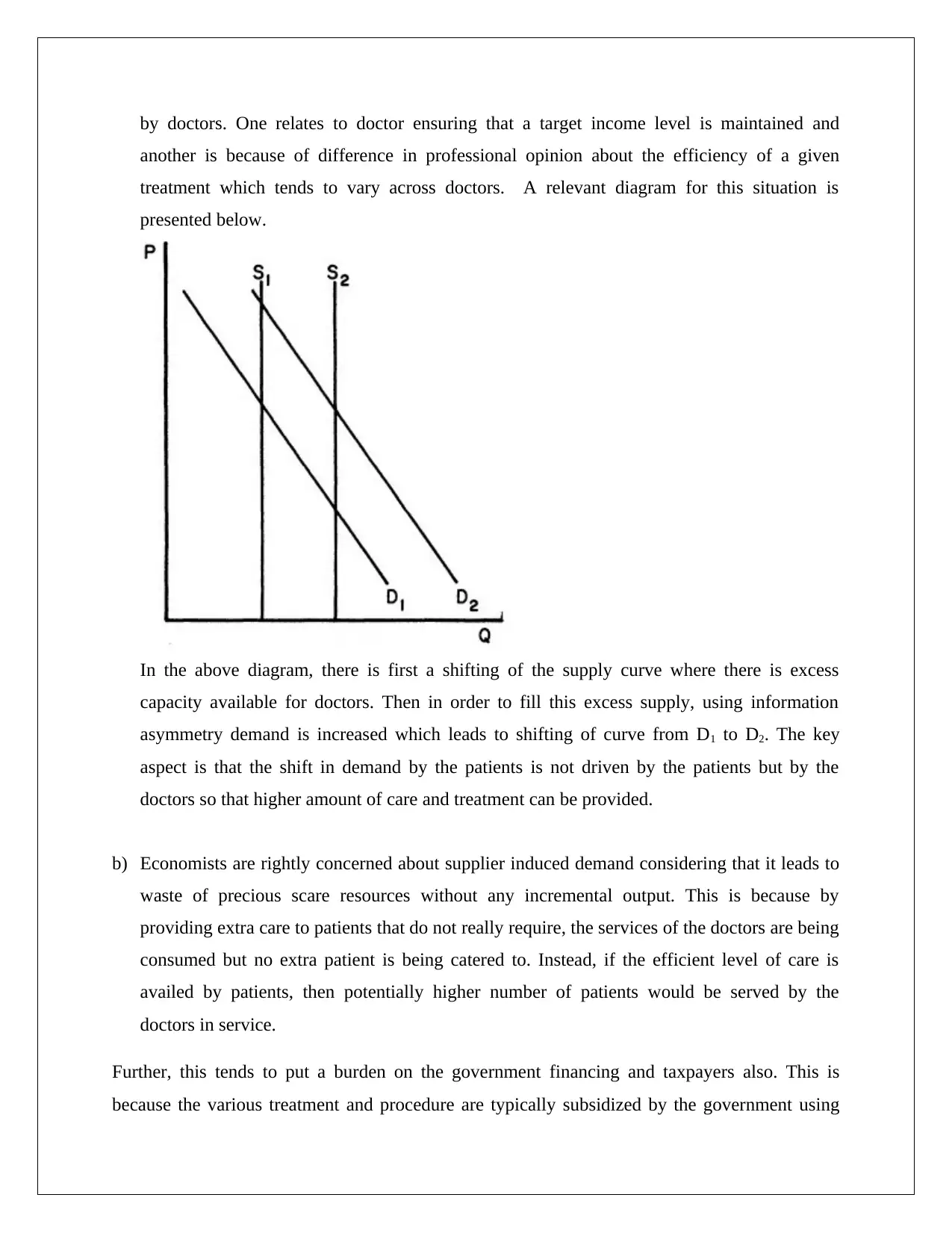
by doctors. One relates to doctor ensuring that a target income level is maintained and
another is because of difference in professional opinion about the efficiency of a given
treatment which tends to vary across doctors. A relevant diagram for this situation is
presented below.
In the above diagram, there is first a shifting of the supply curve where there is excess
capacity available for doctors. Then in order to fill this excess supply, using information
asymmetry demand is increased which leads to shifting of curve from D1 to D2. The key
aspect is that the shift in demand by the patients is not driven by the patients but by the
doctors so that higher amount of care and treatment can be provided.
b) Economists are rightly concerned about supplier induced demand considering that it leads to
waste of precious scare resources without any incremental output. This is because by
providing extra care to patients that do not really require, the services of the doctors are being
consumed but no extra patient is being catered to. Instead, if the efficient level of care is
availed by patients, then potentially higher number of patients would be served by the
doctors in service.
Further, this tends to put a burden on the government financing and taxpayers also. This is
because the various treatment and procedure are typically subsidized by the government using
another is because of difference in professional opinion about the efficiency of a given
treatment which tends to vary across doctors. A relevant diagram for this situation is
presented below.
In the above diagram, there is first a shifting of the supply curve where there is excess
capacity available for doctors. Then in order to fill this excess supply, using information
asymmetry demand is increased which leads to shifting of curve from D1 to D2. The key
aspect is that the shift in demand by the patients is not driven by the patients but by the
doctors so that higher amount of care and treatment can be provided.
b) Economists are rightly concerned about supplier induced demand considering that it leads to
waste of precious scare resources without any incremental output. This is because by
providing extra care to patients that do not really require, the services of the doctors are being
consumed but no extra patient is being catered to. Instead, if the efficient level of care is
availed by patients, then potentially higher number of patients would be served by the
doctors in service.
Further, this tends to put a burden on the government financing and taxpayers also. This is
because the various treatment and procedure are typically subsidized by the government using
⊘ This is a preview!⊘
Do you want full access?
Subscribe today to unlock all pages.

Trusted by 1+ million students worldwide
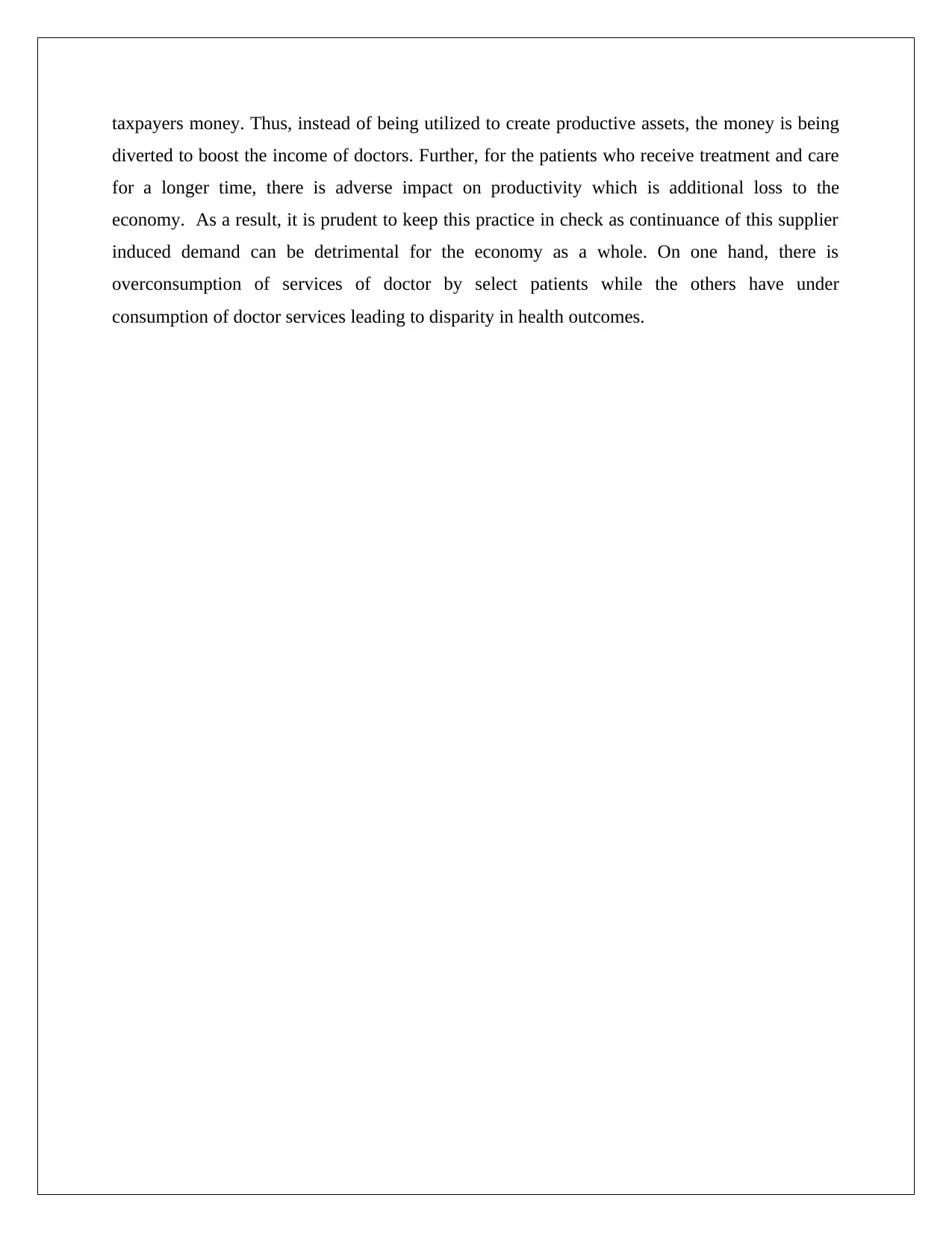
taxpayers money. Thus, instead of being utilized to create productive assets, the money is being
diverted to boost the income of doctors. Further, for the patients who receive treatment and care
for a longer time, there is adverse impact on productivity which is additional loss to the
economy. As a result, it is prudent to keep this practice in check as continuance of this supplier
induced demand can be detrimental for the economy as a whole. On one hand, there is
overconsumption of services of doctor by select patients while the others have under
consumption of doctor services leading to disparity in health outcomes.
diverted to boost the income of doctors. Further, for the patients who receive treatment and care
for a longer time, there is adverse impact on productivity which is additional loss to the
economy. As a result, it is prudent to keep this practice in check as continuance of this supplier
induced demand can be detrimental for the economy as a whole. On one hand, there is
overconsumption of services of doctor by select patients while the others have under
consumption of doctor services leading to disparity in health outcomes.
1 out of 10
Your All-in-One AI-Powered Toolkit for Academic Success.
+13062052269
info@desklib.com
Available 24*7 on WhatsApp / Email
![[object Object]](/_next/static/media/star-bottom.7253800d.svg)
Unlock your academic potential
Copyright © 2020–2025 A2Z Services. All Rights Reserved. Developed and managed by ZUCOL.
